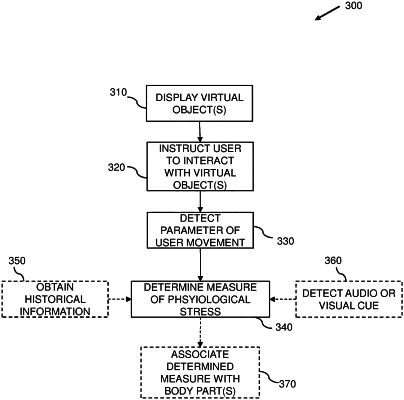| CPC A61B 5/165 (2013.01) [A61B 5/0077 (2013.01); A61B 5/11 (2013.01); A61B 5/162 (2013.01); A61B 5/4803 (2013.01); A61B 5/4884 (2013.01); A61B 5/7278 (2013.01); A61B 5/7445 (2013.01); G06F 3/011 (2013.01); G06T 19/006 (2013.01)] | 8 Claims |

|
1. A computer-implemented method for reducing physiological stress of a user of a virtual reality environment, the method comprising:
displaying to the user a plurality of virtual objects at a plurality of object locations within the virtual reality environment;
continuously detecting a plurality of parameters of movement of the user in response to the plurality of virtual objects, wherein the detected plurality of parameters of movement of the user comprise a reaction time, a speed of movement, and a direction of movement;
continuously detecting spoken words from the user in response to the display of the plurality of virtual objects;
continuously detecting visual cues of the user in response to the display of the plurality of virtual objects;
determining a plurality of measures of physiological stress based on:
a change in the detected plurality of parameters of movement of the user from a plurality of previously-detected parameters of movement by the user;
a comparison of the detected plurality of parameters of movement with one or more additional users of the virtual reality environment;
the detected spoken words; and
the detected visual cues;
associating the plurality of measures of physiological stress with one or more of a plurality of parts of a user's body based on the respective object locations of the plurality of virtual objects to create a body-part-specific mapping for the user,
wherein the body-part-specific mapping includes a plurality of different body parts; and
proactively adapting the virtual reality environment based on the plurality of measures of physiological stress and the body-part-specific mapping to reduce physiological stress on specific ones or more of the plurality of different body parts based on the body-part-specific mapping for the user, wherein the proactive adaptions comprise changing the object location of one or more of the plurality of virtual objects to an adapted object location that reduces physiological stress on one or more of the plurality of parts of the user's body.
|